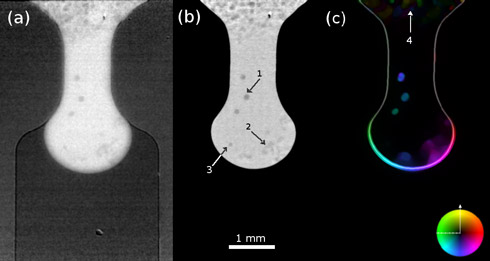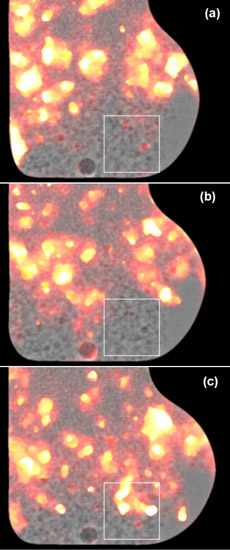- Home
- News
- Spotlight on Science
- Particle and liquid...
Particle and liquid motion in semi-solid aluminium alloys
12-04-2013
Semi-solid casting is a promising process for the production of light-weight metallic components. However, a semi-solid melt exhibits unpredictable flow and filling dynamics when it is injected into thin-walled components. The former were studied by injecting a semi-solid Al-Ge alloy into a thin channel while recording high-resolution radiographs at fast acquisition rates of up to 1000 images/s. Single particle trajectories and rapid break-up of solid skeletons were observed in situ for the first time.
Share
Semi-solid metals are two-phase solid-liquid mixtures of unusual rheological properties [1]. While they are inert, they behave like elastic solids, whereas shearing causes a transition into a viscous mixture which can flow. The transition from a sponge-like locked solid phase filled with a liquid to a viscous medium is marked by the breakup of the (percolated) solid skeleton into particles and/or clusters which can move individually through the liquid. This breakup is commonly referred to as the ‘thixotropic effect’ [2].
For the present work, we recorded X-ray movies with an acquisition rate of 500 images/s at ID15A, the high energy beamline. ID15A has a photon flux density sufficient to record high-resolution radiographs at this elevated frame rate [3]. A dedicated in situ setup has been developed to provide control of temperature and injection force. We used two different thin channels to compare the injection of an Al-Ge32 alloy: a bottleneck channel and a right-angle turn channel. Advanced optical flow analysis was then applied to track and to quantify particle and liquid motion from the measured data separately.
Figure 1 shows three versions of a radiographic image taken from the bottleneck sequence: (a) the normalised raw data, (b) data after filtering, masking and noise reduction and (c) the calculated colour-coded flow field. Noise reduction through filtering was essential to provide sufficient quality for the flow analysis. One can clearly distinguish between liquid and solid phase as the latter appears darker due to the lower X-ray density of aluminium compared to the Ge-rich liquid matrix. Two or three small clusters of solid particles were detached from the solid (arrow 2) and moved through the channel following the liquid-air interface (arrow 3). Along with the liquid, several gas bubbles (arrow 1) flowed into the cavity while the bulk remained more or less inert (arrow 4).
If the experiment were carried out with a different channel geometry (right-angle turn), the flow behaviour would be expected to change. The right-angle was chosen to create a more turbulent flow, in the hope that the motion of both liquid and solid would be more conjoint compared to the bottleneck. The turbulent flow is illustrated by Figure 2 which shows a series of three radiographs situated in the middle of the sequence (a-c) covering the spontaneous break-up of a larger particle cluster, which took place in less than 60 ms. A large region of the solid, approx. 1.5 mm in diameter (highlighted by the box region in Figure 2), remains frozen for approx. 35 ms (Figure 2a), then suddenly the upper half of this cluster breaks up and moves at high speed into different directions, indicated by several flares in Figure 2c (velocity amplitude), while the lower part remains still.
Compared to our previous experiments [4], the present data shows a multitude of dynamic effects, particularly for the new geometry (right angle turn) of the flow channel. Here, isolated turbulent particle motion and transition from a frozen solid skeleton to moving particle/clusters could be observed. The latter, we believe, is the first visual proof of the thixotropic break-up during semi-solid injection.
Movies of semi-solid casting
- Flow field from the bottleneck experiment
- Flow trajectories from the bottleneck experiment
- Flow field from the right angle turn experiment
Figures and movies reprinted from Acta Mater. 61, 1244-1253, Copyright 2013, with permission from Elsevier.
Principal publication and authors
Particle and liquid motion in semi-solid aluminium alloys: A quantitative in situ microradioscopy study, S. Zabler (a), A. Ershov (b), A. Rack (c), F. Garcia-Moreno (d), T. Baumbach (b), J. Banhart (d,e), Acta Mater. 61, 1244-1253 (2013).
(a) Universität Würzburg, Institute of Physics and Astronomy, Würzburg (Germany)
(b) Karlsruher Institute of Technology, ANKA, Karlsruhe (Germany)
(c) ESRF
(d) Helmholtz Center Berlin – Functional Materials, Berlin (Germany)
(e) Technische Universität Berlin, Berlin (Germany)
References
[1] M.C. Flemings, Metall. Trans. A 22, 957-81 (1991).
[2] D.B. Spencer, R. Mehrabian, M.C. Flemings, Metall. Trans. B 3, 1925-32 (1972).
[3] M. Di Michiel, J.M. Merino, D. Fernandez-Carreiras, T. Buslaps, V. Honkimäki, P. Falus, T. Martins, O. Svensson, Rev. Sci. Instrum. 76, 043702 (2005).
[4] S. Zabler, A. Rack, A. Rueda, L. Helfen, F. Garcia-Moreno, J. Banhart, Phys Stat Solid A 207, 718-23 (2010).
Top image: Quantitative optical flow analysis of high-speed micro-radioscopy of semi-solid metal injection processes (colour encodes direction, brightness equals speed).





